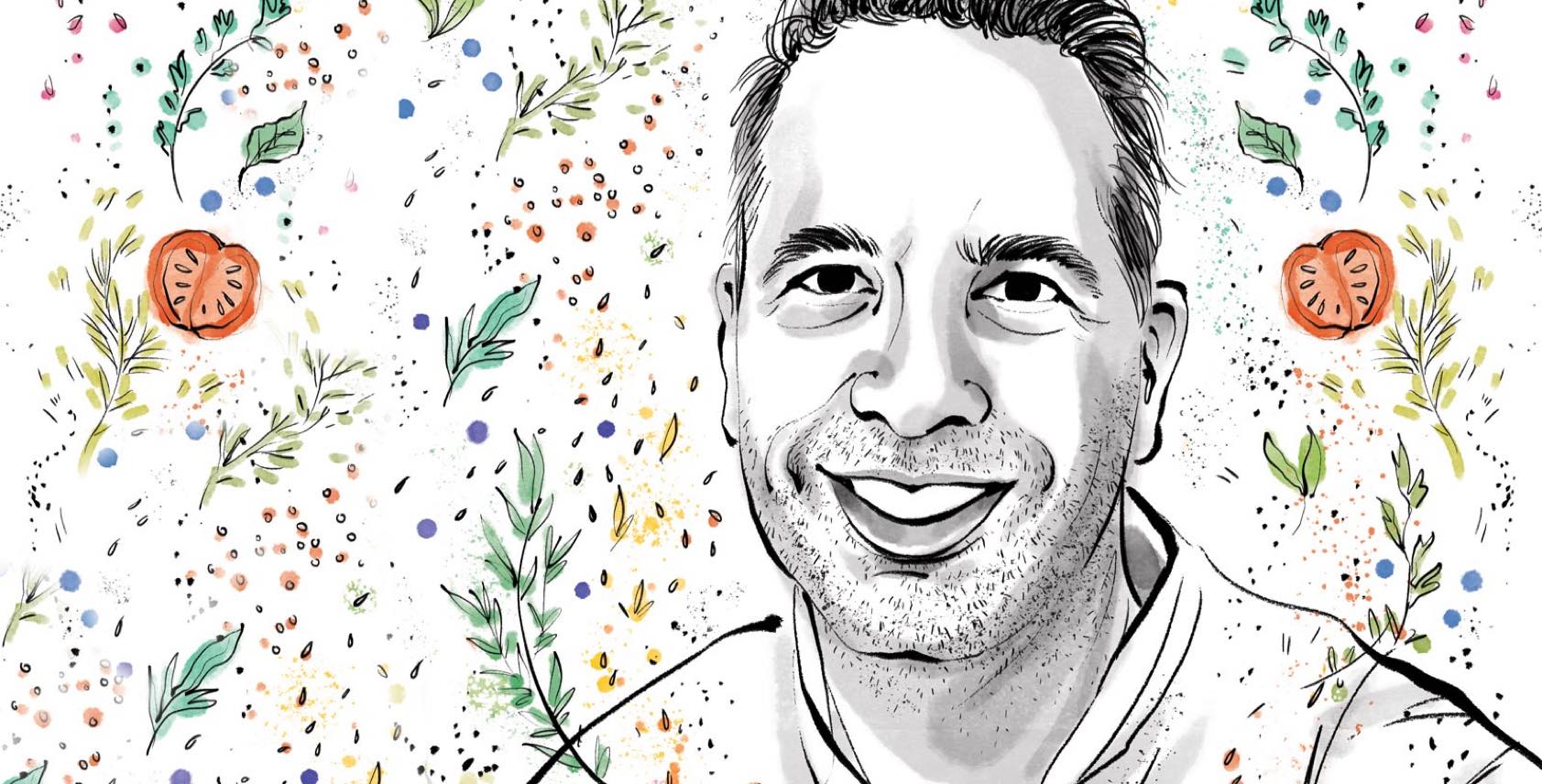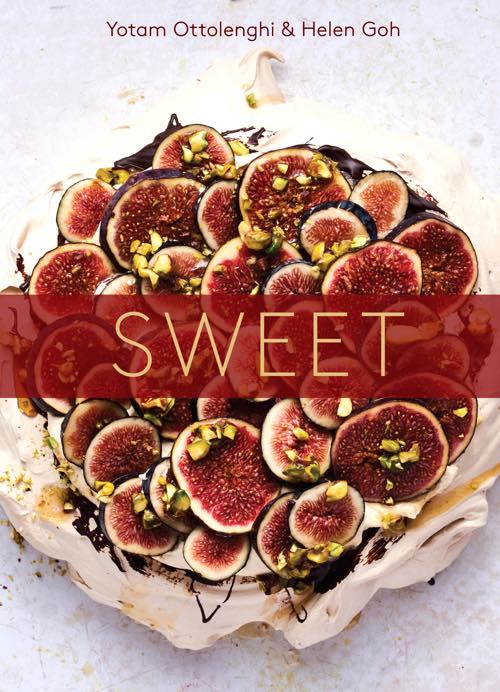Yotam Ottolenghi Wants You To Start Baking Immediately
Walk into any chef’s kitchen and you’re almost as likely to find a tahini yogourt-stained copy of Yotam Ottolenghi’s Plenty as you are to spot a spatula. Over the past decade, the British-Israeli chef has risen to stardom with his star anise– and sumac–filled food bibles. His playfully exotic dishes are so satisfying in part because of the quests they inspire — they push readers out into the world, in search of gooseberries.
Now, Ottolenghi is turning his attention to sugar with a new book, Sweet, dedicated entirely to baked goods and confections. These latest recipes fuse the adventurous flavours of past Ottolenghi cookbooks with technical baking expertise contributed by co-author Helen Goh, a long-time product developer at Ottolenghi’s London restaurants. The results — apricot and amaretto cheesecakes, saffron and pistachio brittle — ensure the chef’s name continues to get dropped with unmatched reverence at foodie dinner parties. And if you’ve never bothered to bake a tray of cookies — well, Ottolenghi has words for you.
I’m reaching you in Ireland. What was the last sweet thing you indulged in there?
Pancakes. My children are on school break, so I’m on holiday here with my family, and this morning we all made them for breakfast — with Canadian maple syrup on top, actually.
Nice — you’re teaching them an appreciation for the craft. What is your reaction to someone who says they can’t bake?
It’s a misconception. If you can read, then you can bake. The recipes are so prescriptive, with exact measurements and far more direction than savoury recipes. If you don’t have a sweet tooth and are not inclined, that’s one thing. But to people who think it’s scary because something can go wrong: read the recipe. Engage with it. Yes, things can go wrong. Even then, often they can be resurrected. If your cake collapses, it can be soaked in rum, covered in cream, and turned into trifle. If a beginner wants a satisfying baking experience that doesn’t require a lot of technical skill, a lemon poppyseed loaf is a good place to start.
You command a cult following of foodies. What’s that like in day-to-day life?
Wherever I go, people tell me which of my recipes work and which were too much of a challenge. More often, they share their successes. They’ll tell me that my chicken recipe became their household favourite. People come up and say “I cook it all the time.” No matter where I am, I like hearing that. It makes the work we did testing it so much more worth it.
I’ve heard you describe recipe development as a quest to achieve “drama in the mouth.” What do you mean by that?
I really enjoy experiencing a sense of surprise as you eat something. I’m always straddling the line between comlexity and, at the same time, comfort. The tension between those two makes food interesting.
“Food images are ever more prominent on social media, but many are not related to recipes at all. We have no idea how these beautiful dishes are made.”
Before becoming a chef, you studied the philosophy of photography. How do you see food photography shaping our relationship with food?
In ever-more-prominent and complicated ways. In the past, a picture of food was typically subservient to a recipe. Now, many social media images are not related to recipes at all. We see these beautiful dishes, but we have no idea how they’re made or what they taste like. In my mind, a beautiful cookbook is a great way to inspire someone to cook, but just reading a cookbook alone is not the same as the actual act of cooking. It is more and more important that people engage in cooking. Pictures are fine, but they’re nothing like the real experience of making and eating something. They don’t even come close.
But visual appeal can still make or break a cookbook. At one point in the book, you write that you had a “momentary wobble that there was not enough colour.”
I did worry with this cookbook, because cakes, by nature, are brown. Plus, I couldn’t garnish with herbs in the same way that I can when I have a stew that doesn’t look great. There’s some room to play with the icings, frostings, glazes, and fruits, but that requires setting out aware that I want to achieve colour. That’s what we did with that stripe cake — adding rich colour by mixing black currants into the buttercream. Strong visuals are important to tempt people. The cover
was its own challenge. You want it to be graphic and tell a story, but not be too explicit. I’m happy with the final choice, a cinnamon pavlova with figs. It’s a dessert that reflects the book — it uses interesting ingredients, and it’s a little bit Middle Eastern.
How do you go about injecting more international flavour into England today?
Helen and I are very aware of the context that we operate in. We enjoy the fact that we bring an outside perspective to Britain, which has a very particular baking culture. Take The Great British Bake-Off — that television show is a whole phenomenon. And although London is international, many British customers come into our shop just looking for biscuits. We love those, too, and appreciate the cultural heritage they have, but when we play around with the local standbys, we definitely develop our own take. We pick from our respective backgrounds and we play. In one case, we took a posset and added papaya on top, which reflects Helen’s culinary heritage growing up in Malaysia.
You and Helen have been working together for 10 years. What’s your approach to effective collaboration?
Always have a good dialogue going. As you work with someone creatively for a while, you develop an understanding of your relationship. Helen has a technical background and is more conservative in how she likes to mix up flavours. I’m less cautious and more “a little bit of this, a little bit of that, let’s see how it works.” When it doesn’t work, Helen is
much more capable at solving problems. She’s the one who will figure out how to add coffee flavour to a pound cake without throwing off its light, spongy texture with too much liquid.
The holidays just wrapped up. How does food help to define an occasion?
We do so much at the shops in the months of November and December — the whole place transforms. Either things are white or they’re red or they have the flavours of Christmas: cinnamon, and allspice. Gifty things — cookies and nougats — line the counters. Plus we make even more meringues than we normally do, decorated with praline. These all help make for a particularly special time because they’re not a necessity. Holiday baking is not something you do quickly at the end of the day — it’s something that you do when you have a real moment. It’s more meditative in that way. And it is often done to be shared or gifted to someone, so it’s emotional, as well.
To return to your kids — what’s your policy as a dad when it comes to their sugar intake?
My husband and I limit sugar, but we do want them to experience sweets. They shouldn’t feel that something is excluded, because that just gives them an unnecessary fascination with it. So instead it’s about creating a space for it on a semi-regular basis. In our house, fruit is usually our sweet thing at the end of a meal. Obviously there are biscuits, too, but not all the time — more on the weekends. And, for birthdays, a chocolate cake with just-rich enough ganache frosting.











